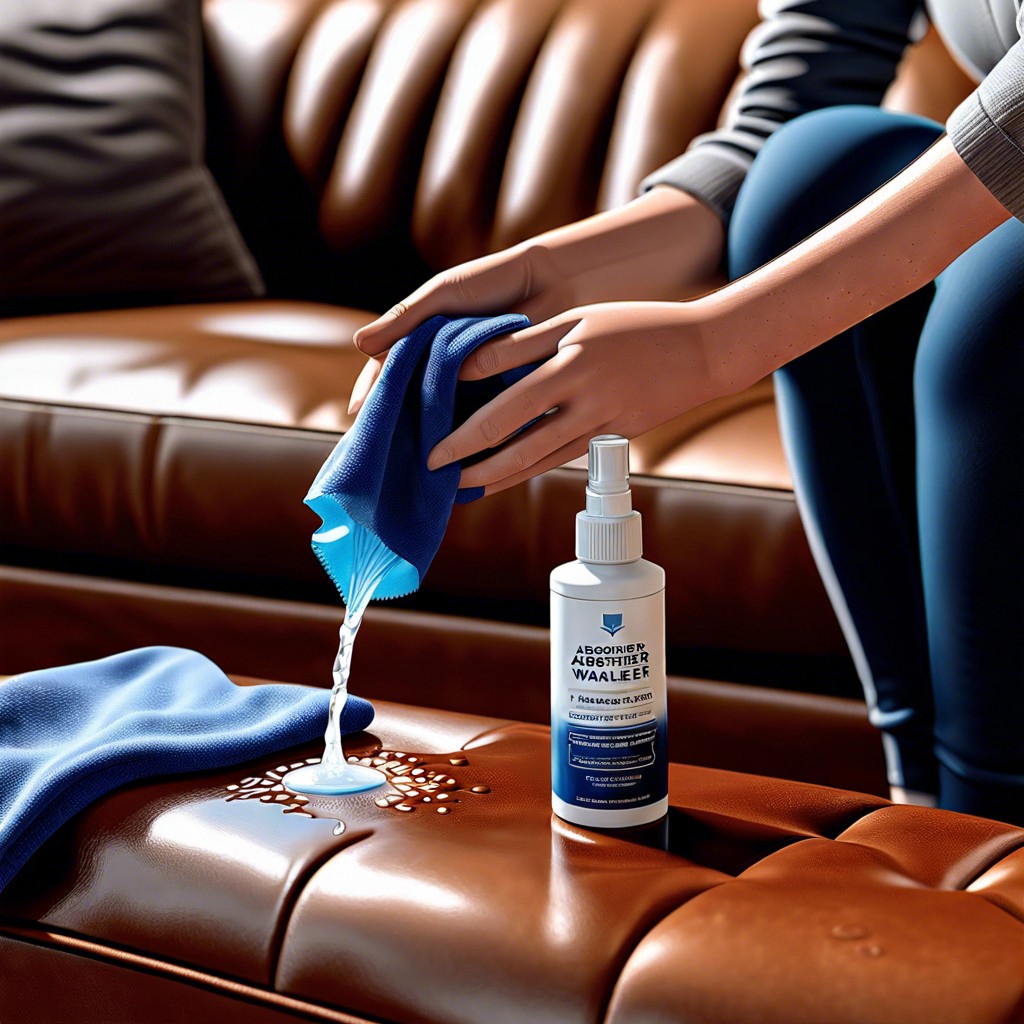Last updated on
Learn the effective steps to eliminate the unpleasant odor of urine from your leather couch with household remedies and proper care techniques.
Key takeaways:
- Blot urine immediately to prevent lasting odor.
- Use a mild, water-based leather cleaner or vinegar solution.
- Blot and gently clean the stained area with the solution.
- Neutralize lingering odors with vinegar or activated charcoal.
- Condition leather regularly to maintain its resilience and protect it.
Table of Contents
Cleaning Up The Initial Mess

Begin by blotting up as much urine as possible using a clean, dry cloth or paper towels. Press firmly to absorb the liquid, but avoid rubbing as this can spread the urine or push it further into the leather. Work from the outside of the stain towards the center to contain the mess. Take care not to saturate the leather with too much liquid during this process, which can cause additional staining or damage. If the pee has already dried, lightly dampen the affected area with warm water to loosen it before blotting. Remember that quick action is key; the sooner you address the spill, the less likely it is to leave a lasting odor.
Choosing The Right Cleaning Solution
Selecting an appropriate cleaning solution is critical to safely remove urine from a leather couch without causing damage. Use a mild, water-based cleaner specifically designed for leather, which will preserve the couch’s color and texture. Avoid harsh chemicals and bleach, as these can discolor and weaken the leather.
Consider a mixture of equal parts water and white vinegar as a natural alternative; the vinegar acts as a disinfectant while also neutralizing odors. For persistent smells, adding a small quantity of baking soda to the solution can be effective due to its odor-absorbing properties.
Always perform a spot test on a hidden area to ensure the cleaner doesn’t harm the leather. Once you have confirmed the cleaner is safe for use, apply it with a soft, clean cloth, gently wiping the stained area without saturating the leather, as excess moisture can lead to further issues.
Cleaning The Urine Stains
Begin by blotting any wet urine spots with a clean cloth to absorb as much liquid as possible; avoid rubbing as it can spread the urine deeper into the leather. For dried stains, lightly dampen the cloth with water to soften the spot before blotting.
Next, prepare a mild solution by mixing one part water and one part vinegar. Dip a clean cloth into the solution, wring it out so it’s damp but not wet, and gently clean the stained area. Vinegar not only cleans but helps to neutralize odors.
For persistent stains or if you prefer not to use vinegar, consider a leather-safe enzyme cleaner. These enzymatic solutions break down the proteins in urine, eliminating both the stain and the smell. Apply according to the product’s instructions, testing on a small, inconspicuous area first to ensure it doesn’t harm the leather.
After cleaning, take another clean, dry cloth to wipe the leather surface. This will remove any remaining cleaner and help to prevent watermarks. Remember, leather is sensitive to liquids; always use the minimal amount of cleaning solution and dry the area thoroughly.
Neutralize Any Leftover Scents With Vinegar or Charcoal
Once the urine stain has been treated, there might still be a lingering odor. At this point, vinegar, a natural deodorizer, can work wonders. Create a solution of equal parts water and vinegar, and lightly apply it to the affected area with a cloth. Be sure not to over-wet the leather, as this could cause more harm than good. Allow it to air-dry completely. If the smell persists, consider placing a bowl of activated charcoal near the couch. Activated charcoal is highly absorbent and can effectively pull odors from the air, making it an excellent choice for persistent smells that don’t want to leave your leather couch. Remember to keep the room well-ventilated throughout this process for the best results.
Conditioning And Protecting The Leather Couch
After addressing the unpleasant smell, it’s imperative to maintain your leather couch’s resilience and elegance. Leather is naturally durable but also requires nourishment to prevent cracks and premature aging, especially after exposure to cleaning agents.
Apply a high-quality leather conditioner with a soft cloth, working it in gentle, circular motions. Conditioning not only restores moisture lost during the cleaning process but also forms a protective barrier, making future accidents easier to address. Allow the conditioner to penetrate the leather; this may take a couple of hours.
Protecting your couch further involves simple, precautionary measures. Keep it out of direct sunlight, which can cause fading and drying over time. Also, consider using a throw blanket or furniture cover if pets frequently climb on the couch. This can prevent accidental damage and make routine cleaning a swift task.
Regular maintenance, including light dusting and periodic conditioning, will keep the leather supple. A conditioned and protected leather couch results in a lasting, inviting piece that continues to add character and comfort to your space.




